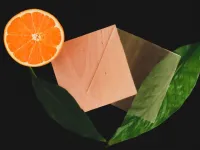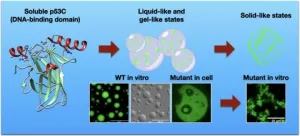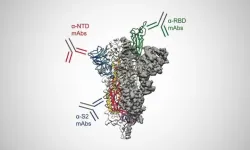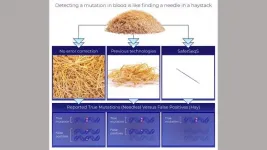(Press-News.org) Since it was first introduced in 2016, transparent wood has been developed by researchers at KTH Royal Institute of Technology as an innovative structural material for building construction. It lets natural light through and can even store thermal energy.
The key to making wood into a transparent composite material is to strip out its lignin, the major light-absorbing component in wood. But the empty pores left behind by the absence of lignin need to be filled with something that restores the wood's strength and allows light to permeate.
In earlier versions of the composite, researchers at KTH's Wallenberg Wood Science Centre used fossil-based polymers. Now, the researchers have successfully tested an eco-friendly alternative: limonene acrylate, a monomer made from limonene. They reported their results in Advanced Science.
"The new limonene acrylate it is made from renewable citrus, such as peel waste that can be recycled from the orange juice industry," says lead author, PhD student Céline Montanari.
An extract from orange juice production is used to create the polymer that restores delignified wood's strength and allows light to pass through.
The new composite offers optical transmittance of 90 percent at 1.2 mm thickness and remarkably low haze of 30 percent, the researchers report. Unlike other transparent wood composites developed during the past five years, the material developed at KTH is intended for structural use. It shows heavy-duty mechanical performance: with a strength of 174 MPa (25.2 ksi) and elasticity of 17 GPa (or about 2.5 Mpsi).
Yet all along, sustainability has been a priority for the research group, says Professor Lars Berglund, the head of the KTH's Department of Fibre and Polymer Technology.
"Replacing the fossil-based polymers has been one of the challenges we have had in making sustainable transparent wood," Berglund says.
Environmental considerations and so-called green chemistry permeate the entire work, he says. The material is made with no solvents, and all chemicals are derived from bio-based raw materials.
The new advances could enable a yet unexplored range of applications, such as in wood nanotechnology, Berglund says. Possibilities include smart windows, wood for heat-storage, wood that has built-in lighting function - even a wooden laser.
"We have looked at where the light goes, and what happens when it hits the cellulose," Berglund says. "Some of the light goes straight through the wood, and makes the material transparent. Some of the light is refracted and scattered at different angles and gives pleasant effects in lighting applications."
The team is also working with Sergei Popov's photonics group at KTH to explore the nanotechnology possibilities even further.
INFORMATION:
Cancer has been recently shown to be affected by protein clusters, particularly by the aggregation of mutant variants of the tumor suppressor protein p53, which are present in more than half of malignant tumors. However, how the aggregates are formed is not yet fully understood. The understanding of this process is expected to provide new therapeutic tools able to prevent proteins to clump and cancer progression.
In Brazil, researchers at the Federal University of Rio de Janeiro have identified a key mechanism behind the mutant p53 aggregation process, linked to cancer pathology, opening new paths for the development of novels ...
BAR HARBOR, MAINE — Our kidneys are charged with the extraordinary task of filtering about 53 gallons of fluid a day, a process that depends on podocytes, tiny, highly specialized cells in the cluster of blood vessels in the kidney where waste is filtered that are highly vulnerable to damage.
In research at the MDI Biological Laboratory in Bar Harbor, Maine, a team led by Iain Drummond, Ph.D., director of the Kathryn W. Davis Center for Regenerative Biology and Aging, has identified the signaling mechanisms underlying podocyte formation, or morphogenesis. The discovery opens the door to ...
A team of University of Alberta researchers has discovered a way to use 3-D bioprinting technology to create custom-shaped cartilage for use in surgical procedures. The work aims to make it easier for surgeons to safely restore the features of skin cancer patients living with nasal cartilage defects after surgery.
The researchers used a specially designed hydrogel--a material similar to Jell-O--that could be mixed with cells harvested from a patient and then printed in a specific shape captured through 3-D imaging. Over a matter of weeks, the material is cultured in a lab to become functional cartilage.
"It takes a lifetime to make cartilage in an individual, while this method takes about four weeks. So you still expect ...
Metallacages prepared via coordination-driven self-assembly have received extensive attention because of their three-dimensional layout and cavity-cored nature. The construction of light-emitting materials employing metallacages as a platform has also gained significant interest due to their good modularity in photophysical properties, which bring emerging applications in fields as diverse as sensing, biomedicine, and catalysis.
However, the luminescence efficiency of conventional luminophores significantly decreases in the aggregate state because they encounter unfavorable aggregation-caused quenching (ACQ). Therefore, it was quite a challenge to fabricate light-emitting metallacages with high luminescence efficiency in various physical states.
In 2001, Tang's group ...
The most complete picture yet is coming into focus of how antibodies produced in people who effectively fight off SARS-CoV-2 work to neutralize the part of the virus responsible for causing infection. In the journal Science, researchers at The University of Texas at Austin describe the finding, which represents good news for designing the next generation of vaccines to protect against variants of the virus or future emerging coronaviruses.
Previous research focused on one group of antibodies that target the most obvious part of the coronavirus's spike protein, called the receptor-binding domain (RBD). Because the RBD is the part of the spike that attaches directly to human cells and enables the virus to infect them, ...
New York, NY (May 4, 2021) - A powerful, long-term study from WCS adds scientific backing for global calls for conserving 30 percent of the world's ocean. The studied no-take marine protected areas (MPAs) increased the growth of fish populations by 42 percent when fishing was unsustainable in surrounding areas, achieving the benefits of stable and high production of fish populations for fishers, while protecting threatened ecosystems.
The study recorded fish catches for 24-years across a dozen fish landing sites within two counties in Kenya, which allowed scientists to evaluate the long-term impacts of two different fisheries management methods. While one county ...
Harsh prison sentences for juvenile crimes do not reduce the probability of conviction for violent crimes as an adult, and actually increase the propensity for conviction of drug-related crimes, finds a new study by economists at UC Riverside and the University of Louisiana. Harsh juvenile sentences do reduce the likelihood of conviction for property crimes as an adult. But the increase in drug-related crimes cancels out any benefit harsh sentences might offer, researchers found.
"Juvenile incarceration is a double-edged sword which deters future property crimes but makes drug convictions more likely in adulthood. Thus, it's hard to make firm policy recommendations ...
Scientists believe a stomach-specific protein plays a major role in the progression of obesity, according to new research in Scientific Reports. The study co-authored by an Indiana University School of Medicine researcher, could help with development of therapeutics that would help individuals struggling with achieving and maintaining weight loss.
Researchers focused on Gastrokine-1 (GKN1) -- a protein produced exclusively and abundantly in the stomach. Previous research has suggested GKN1 is resistant to digestion, allowing it to pass into the intestine and interact with microbes in the gut.
In the Scientific Reports study, researchers show that inhibiting GKN1 produced significant differences in weight and levels of body fat in comparison to when the protein was expressed.
"While ...
Next-generation gene sequencing (NGS) technologies --in which millions of DNA molecules are simultaneously but individually analyzed-- theoretically provides researchers and clinicians the ability to noninvasively identify mutations in the blood stream. Identifying such mutations enables earlier diagnosis of cancer and can inform treatment decisions. Johns Hopkins Kimmel Cancer Center researchers developed a new technology to overcome the inefficiencies and high error rates common among next-generation sequencing techniques that have previously limited their clinical application.
To correct for these sequencing errors, the research team from the Ludwig Center and Lustgarten Laboratory at the Johns Hopkins ...
ROCHESTER, Minn. -- A pair of Mayo Clinic studies shed light on something that is typically difficult to see with the eye: respiratory aerosols. Such aerosol particles of varying sizes are a common component of breath, and they are a typical mode of transmission for respiratory viruses like COVID-19 to spread to other people and surfaces.
Researchers who conduct exercise stress tests for heart patients at Mayo Clinic found that exercising at increasing levels of exertion increased the aerosol concentration in the surrounding room. Then also found that a high-efficiency particulate air (HEPA) device effectively filtered out the aerosols and decreased the time needed to ...






